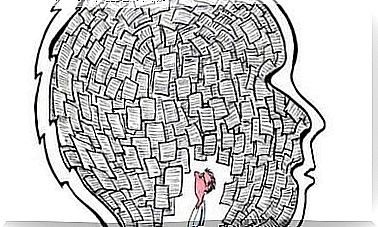How To Defend Against Passive Aggressiveness

Passive-aggressive behavior is characterized by addiction and manipulation. His devious art combines a negative attitude with pervasive pessimism. These are so strong that they drag others down to a point of deep mental and emotional exhaustion. Likewise, these characteristics mark a defiant personality, which unfortunately is very common. This type of behavior complicates any type of relationship, whether it’s a romantic, platonic, or family relationship. How can we defend ourselves against passive aggressiveness?
Something that most of us can spot almost immediately is aggressive behavior. Usually all of us are vigilant enough to notice this type of behavior. Whether it is about violent attitudes or types of communication, or more or less explicit aggressiveness, we recognize aggressive people.
“Fear is usually expressed in two ways: through aggression or through submission.”
Paolo Coelho
However, in the way we have described aggressive behavior, we cannot always identify passive-aggressive behavior when it is on the march. It is not always easy to translate certain attitudes or reactions that can range between charismatic and reactionary. What stands out, however, is the hostility that is masked by irony, sarcasm, and “good behavior”. It’s a personality type that is confusing and leads you to make mistakes. It is only slowly that we finally become aware of the specific damage this person is causing us. On the other hand, it is noteworthy that until a few years ago, passive aggressiveness was classified as a personality disorder. However, this clinical classification has disappeared in the 4th edition of the DSM (Diagnostic and Statistical Manual of Mental Disorders) . Now it is classified as a behavior type, namely a “non-morbid” personality type. In the 1990s, this supposed disorder was diagnosed too often. Such a great controversy arose that the experts came to the conclusion that it makes no sense to view resistance, pessimism or covert aggression as pathological. It would only apply to a person who persists in this dominant, pessimistic, and devaluing attitude.

Signs of passive-aggressive behavior
We can all be passive-aggressive at one point in time. Without even realizing it, there are certain triggers that can provoke suppressed hostility and irritable and bad-tempered reactions. So it is important to always understand what is behind certain types of passive-aggressive behavior.
Let’s look in detail at what are some of the most common hallmarks.
Passive aggressive language
Passive-aggressive behavior always hides a hidden anger. It is very well hidden and it is particularly evident through the language. Hints are often used, those that are hurtful and unprepared for the listener. The use of confusing and even contradicting messages is also very common, such as the following sentences:
- “I don’t understand what you are trying to tell me” (even if you know exactly what we want to communicate).
- “Whatever you want” (affirmations that end the discussion as quickly as possible to avoid serious and direct emotional communication).
- “Why are you acting like that? You take everything so seriously ” (the passive aggressive person uses these types of sentences to humiliate the listener and push them to the limit).
Behavioral Hostility and Delay
Passive-aggressive people may appear nice and open, but the picture collapses as soon as we get to know them a little better. Then we see their true, passive-aggressive side.
- They tend to be shy and criticize everything around them.
- These people can be disrespectful, which makes them proud because they see themselves as rebellious and against the establishment.
- Often times they are addicted to blaming others for everything.
- Bitterness and nagging are two deep roots in the heart of a passive aggressive person.
- They don’t like authority or suggestions from other people.
On the other hand, with this hostility comes a tendency to postpone almost everything until tomorrow. They don’t do what they promise, they start things and leave them halfway there. They are forgetful and they are not careful with what they have. Regardless of whether these are objects or personal relationships.

Emotional dependence
It is interesting that their behavioral hostility and their rebellious and hostile attitudes actually lead them to develop a strong emotional dependence on others.
Their motto, which is most characteristic of them, is without a doubt the attitude “I look down on you, but I need you.” It is a trait that a weak person hides behind who feels small because of his insecurities. It is a person who needs everything from others, but at the same time lives in the bitter crust of its hard outer shell.
How to deal with a passive aggressive person
There are various and sometimes complex realities behind passive-aggressive behavior: depression, anxiety disorder, attention deficit hyperactivity disorder (ADHD), poor self-esteem, a bad childhood, or even certain biological or environmental factors.
“Those who get caught up in a competition of aggressiveness lose their sanity and, most importantly, their strength.”
Julian Marias
If you realize that your daily behavior and attitudes are creating passive-aggressive behavior, then it is best to find a good therapist. He can help you understand your anger and frustration and point them in the right direction. Also, it’s not a bad idea to keep the following basic strategies in mind:
- Try to understand why you are acting and reacting this way.
- Think and reflect before you speak or act.
- Find out what hits you the most, what worries you, and try to confront it.
- Defeat your negative attitudes
- Practice mindfulness.
- Cultivate your emotional intelligence.

Ignore as a method
On the other hand, the best way to reduce the influence of passive-aggressive people on us is to ignore them. In general, a passive aggressive person has very low self-esteem and lacks emotional self-assertion. This person does not know how to act if they feel that their behavior is not having any effect. The more these people feel that we are being struck by their words and attitudes, the more power they have.
On the other hand, if they see that we don’t mind, they won’t move on and their psychological impact on us will be weakened. That said, it’s always good to know what’s behind this type of behavior. If the passive aggressive person is a relative, we can encourage them to seek professional help.
In summary, we conclude with this interesting fact about the origin of this term and when it was first used. It was during World War II that a group of military psychologists noticed that many soldiers displayed a certain degree of rebellious behavior. They showed passive and negative resistance when it came to following orders. The real reason these soldiers behaved was post-traumatic stress …









